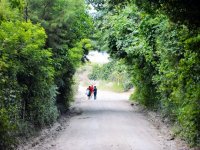Alternate Education for Rural Development: A Practical, Successful Solution
An award-winning program in rural Peru successfully integrates secondary education and entrepreneurship with students’ need to work on family farms and develop their local economies.
Your content has been saved!
Go to My Saved Content.Can you imagine walking eight hours per day to get to school? This is one of the problems that young people face in Peru's rural communities.
If you live in a rural community, it is likely that your school schedule does not consider either the agricultural calendar or the distance between your home and the school. You probably feel exhausted every day because you have to work at home and study at the same time -- and you can't do all because you aren't Superman.
If this is your situation, it's most likely that you abandon school and lose the opportunity to help with your community's development.
Meeting a Need With Alternate Education
Young people in the rural communities of Peru usually abandon their secondary education at an early stage due to family work schedules, long distances to schools, and a lack of job opportunities which could help them make productive contributions to their communities. Therefore, many parents don't see how attending secondary school and learning its curriculum could be useful for the children and the family.
Rural communities in Peru, where the work is primarily in subsistence agriculture and livestock, have a high poverty index. Young people have only two options:
- Work on the family farm.
- Migrate to urban centers seeking a job and a better education.
In this scenario, Fundación CODESPA promotes the Alternate Education for Rural Development in Peru project to help young people achieve a proper education. The project gives students integral training based on three dimensions: academic, human, and technical-productive:
- The first dimension is aligned with the competencies required by Peru's Ministry of Education.
- The second dimension aims to develop competencies and skills for students' personal and job performance.
- The third dimension is related to the productive and technical skills required to develop a business plan in students' community.
These three dimensions are integrated into a training plan for each school.
Elements of a Successful Program
The Alternate Education program allows young people the access to school and the ability to stay there by offering a proper education adapted to both their rural and academic needs. It integrates social environment and family life with the educational environment by alternating school and family time every two weeks to avoid the necessity for students to travel long distances every day. This program also promotes the entrepreneurial spirit, because students are expected to carry out small productive projects on their farms, with their parents' help. Finally, they are able to make a business plan to work in their community. For this reason, it's important to reinforce a real trust between parents and children, and for parents to stay involved in their children's education.
One of the project's more important aspects is the quality and training of teachers. Teachers are engaged in ongoing professional development, beginning with two years of initial training, followed by additional training at the beginning of every academic year. This plan helps them better adapt educational goals and practices to students' evolving, alternating needs as residents of the school community and participants in their home communities' economic development. Additionally, teachers meet with parents once a month update them about their children's progress.
Methodology
- Students alternate two-week periods in the family environment with two-week periods at school.
- School curriculum is adapted to rural reality and focused on practical issues.
- Teachers have ongoing training.
- Parents are involved in the school's management and the teachers' training.
- Schools are accessible and provide nearby facilities to house students for two weeks at a time.
The Alternate Education program is an innovative methodology that has been operating successfully since 2002. The idea originated with David Bauman, a Peruvian engineer. At the beginning there were just three schools. It is currently practiced by 45 alternate rural schools in 11 Peruvian regions, assisting 2,823 young people. In 2013, 1,657 students graduated from these secondary schools. Of the program's graduates through 2012, 52 percent are studying tertiary education, and 68 percent are working autonomously. Of these young people, 78 percent remain linked to their family and community, and 31 percent are creating and carrying out their own business plans. From this point of view, it's clear to see how the project helps its graduates increase family incomes.
Empowering Young Women
Do you know that, according to UNESCO's Girls' Education Initiative (PDF), every year that a girl spends in school can boost her future income by 10-20 percent?
Awareness of this critical fact has driven CODESPA's work. Part of the reason that our organization won the 2014 World Innovation Summit for Education Award is that the Alternate Education project, whose direct beneficiaries are young people age 11-18 who live in poor rural areas, places a special focus on women. Future scholarship programs for women will help to increase young women's access to and graduation from schools, and will reduce the gender inequality, which is a great problem in Peruvian areas. These scholarships for girls will empower women and lead them to better jobs in the future.
